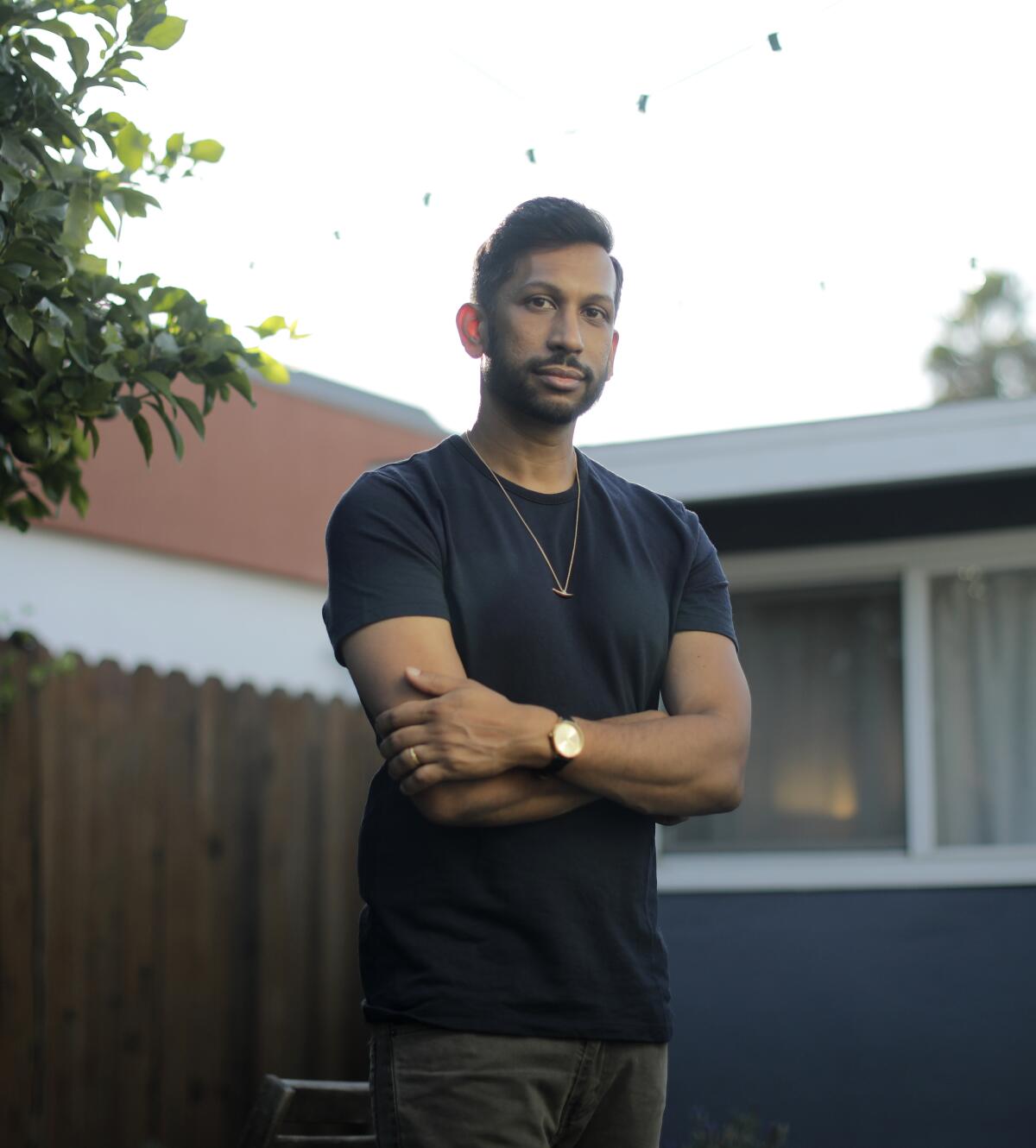How the hit music podcast ‘Song Exploder’ became a Netflix series
Among the first instruments you hear in “Losing My Religion,” the 1991 smash hit by R.E.M., is a mandolin. Played by guitarist Peter Buck, the minimalist melody moves through the song virtually unimpeded. Take it away and the song collapses. Opt instead for a piano, saxophone or a distorted electric guitar and it’s a different thing altogether.
But why? And how did that mandolin riff, combined with bassist Mike Mills’ fluid undercurrent, Bill Berry’s disco-informed drumming and singer Michael Stipe’s disorienting confession — “Oh no I’ve said too much / I haven’t said enough” — come to propel an already successful band from Athens, Ga., to the next level of stardom?
“Peter … was tired of being an electric guitar god, and he wanted to explore acoustic instruments and go in a different direction,” explains Stipe in one of the inaugural episodes of “Song Exploder,” a new Netflix series adapted from creator Hrishikesh Hirway’s acclaimed podcast of the same name. Each of the four episodes, which began streaming on Friday, focus on a single song, and across 25 minutes Hirway grills the artist on how the work was created.
“It was time to do something different,” adds Buck in the R.E.M. episode, of the “Losing My Religion” riff. “We just thought, ‘We’ll make a record that will destroy our career and it’ll be cool.’”
“Song Exploder” is rich with incisive conversations on the creative process. Executive-produced by Hirway with documentarians Morgan Neville and Caitrin Rogers — both of whom in 2014 won Oscars in the feature-length documentary category for “20 Feet from Stardom” — the inaugural season also features installments with Alicia Keys, Lin-Manuel Miranda and Ty Dolla Sign.

“I love the fact that you never know how a song is going to come together,” Keys says in the series, discussing her new song “3 Hour Drive.” “I love the anxiety you feel when you’re like, ‘There’s a pretty likely chance that … I’m not going to find the right words. I’m not going to find the right melody.’”
The TV adaptation is the latest evolution of a music podcast that helped define the genre when it was launched in 2014.
On the eve of the release of a solo concert film, Fleetwood Mac star Stevie Nicks opens up on Lindsey Buckingham’s exit and looking for love in her 70s.
The Eagle Rock-based Hirway, 41, first earned attention under the moniker One A.M. Radio. Across four albums for the Silver Lake-based Dangerbird Records imprint, Hirway’s solo project began as part of a larger aspiration to score films. About seven years ago, during a lull after composing music for indie films “Save the Date” and “Our Nixon,” Hirway found himself with time to ponder a few projects that had been on his mind. He calls it “one of those daydreams — ‘If I ever had the time, I would love to do something like this.’ ‘Song Exploder’ lived in that filing cabinet.”
Because Hirway is a self-taught musician, at the time he was “voracious for anything where artists would let people in on the secrets, how they did what they did.” When friends such as Jimmy Tamborello of synth-pop band the Postal Service or Alfred Darlington, better known as Daedelus, made good songs, Hirway would press them for details on process. Hirway viewed their artistic achievements as “something that I was striving for — but often felt like it was just out of reach.”

An excerpt from “Song Exploder,” the new Netflix adaptation of Hrishi Hirway’s podcast of the same name.
He became convinced that “Song Exploder” would appeal to kindred fanatics eager to learn about the creation of their favorite jams. But at the time, the platforms he approached were less interested in audio as a form of original content. “In 2013,” recalls Hirway, “I took it to Spotify. But they were just focused on video at the time. So they, along with everybody else, passed on the idea.”
He forged on, teaming first with public radio and producer-host Jesse Thorn’s podcast network Maximum Fun before moving a few seasons later to his current distribution home, Radiotopia. Since its launch, “Song Exploder” has consistently ranked among the most consumed music podcasts in the business. By episode No. 42 he’d secured U2 as a guest, and has since spoken to artists including Iggy Pop, Tame Impala, Sheryl Crow, Ghostface Killah, Grimes, Aimee Mann and dozens more. In the most recent installment (episode #193), Hirway talks with pop superstar Selena Gomez and her co-writers about her hit “Lose You to Love Me.”
Behind the scenes, the podcast’s success quickly prompted conversations about a TV adaptation. After hooking up about three years ago with director Neville, who was a regular listener to the podcast, the team started taking meetings. Netflix immediately made an offer, which was a huge boost for Hirway. “It was going to be a tricky show to make, but Netflix was excited from the get-go.” In order to work on the TV series, Hirway took a leave of absence from the podcast after episode 150 and invited Thao Nguyen of Thao & the Get Down Stay Down to guest host.
Hirway notes the irony that, seven years after Spotify passed on the podcast pitch, it and other audio platforms are making huge deals for original podcasts — while at the same time the “Song Exploder” podcast has graduated to a video-based Netflix show.
Spotify, in fact, recently announced a content partnership with longtime entertainment executive and producer Peter Chernin, whose company is responsible for films and TV shows including “Ford v Ferrari,” “Rise of the Planet of the Apes” and “New Girl.” The deal allows Chernin Entertainment right of first refusal in adapting stories from Spotify’s increasingly deep podcast network, which it built by acquiring audio-driven studios The Ringer, Gimlet Media and Parcast.
Already famous, K-pop girl group Blackpink has just released a debut album that mainly evokes the expensive technology and hours of rehearsal required to create it.
Structurally, each episode of the “Song Exploder” Netflix series follows the template that Hirway forged with the podcast. The artists’ work is first introduced with enough historical context to hook newcomers. Then the creators arrive and, armed with the master recordings, they and Hirway “explode” the song.
By playing the various “stems” of instrumentation — isolated bass, drums, keyboards, effects, cowbell, handclaps, vocals, whatever — that make up the final song, he taps their muses for memories. Why no high-hat? Whose idea was that momentous half-measure of silence? Questions answered, the episodes conclude with Hirway pausing a few beats. As if ringing a meditation bell, he introduces the song’s title and creator. Regardless of length, the work then plays in its entirety and without interruption. For the new show, these playbacks are accompanied by visual interpretations that read as half lyric video, half animated wallpaper. When the song ends, the episode does too.
For Stipe, the idea of breaking down “Losing My Religion” was appealing, he said last week, even if he needed a little encouragement beforehand. “Peter and Mike and Bill were really excited about the prospect of examining ‘Losing My Religion,’ which is such a bizarre, weird song,” said Stipe.
He said he remains mystified by “Losing My Religion” and its creation. After Buck came up with that mandolin part, the rest took care of itself. “Normally you would rearrange. You would move things around,” Stipe explained. “You would change this part or that part. Add an intro, add a coda, etc. None of that happened. It’s just one of those that feels like magic, like it landed from somewhere else.”
The R.E.M. episode, in fact, is a revelatory glimpse into the oft-shy Stipe’s process. He winces and cringes when he hears his voice in isolation. Hirway said he has long strived for “a moment like that with Michael Stipe — whose voice is so beloved — to see him surprised.”
As with the podcast, the Netflix production’s aim is to reflect Hirway’s omnivorous appetite for genre-spanning songs. “I knew from the outset that I wanted to feature songs from all different genres and all different backgrounds,” he said. Even though he has diverse tastes in his own day to day listening habits, Hirway strived to expand beyond them, believing that “every episode was a chance to reach somebody new.”
That instinct is apparent throughout the inaugural episodes of the Netflix series. The thrill of watching Lin-Manuel Miranda breaking down how he and producer Alex Lacamoire captured “Wait for It,” from the blockbuster musical “Hamilton,” might give you tingles. Recalling the moment he came up with the song’s chorus, Miranda describes being on a subway to Williamsburg headed to a friend’s party.
He was trying to crack the song’s code, “and the chorus landed just as I was getting to the party,” Miranda explains in the episode. “I was listening to the loop and recording a voice memo at the same time ... walking through the streets of Williamsburg going like, ‘Death doesn’t discriminate / Between the sinners and the saints.’”
After Miranda sets up the scene, Hirway wonders whether Miranda kept the voice memo. A few seconds later, Miranda is staring at the camera as if in selfie mode, listening to the original recording of him hustling through Williamsburg, his voice huffing with each step, as he recites lyrics that, a few years later, would be memorized by millions.
“The creative process is a really compelling way to get a portrait of an artist,” concludes Hirway. “If you approach it with this really granular specificity, you will get insights that you otherwise wouldn’t.”
More to Read
The biggest entertainment stories
Get our big stories about Hollywood, film, television, music, arts, culture and more right in your inbox as soon as they publish.
You may occasionally receive promotional content from the Los Angeles Times.











